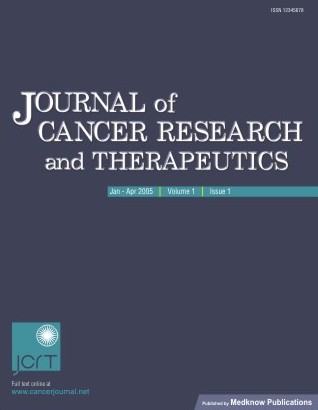
|
Journal of Cancer Research and Therapeutics
Medknow Publications on behalf of the Association of Radiation Oncologists of India (AROI)
ISSN: 0973-1482 EISSN: 1998-4138
Vol. 7, Num. 1, 2011, pp. 99-100
|
Journal of Cancer Research and Therapeutics, Vol. 7, No. 1, January-March, 2011, pp. 99-100
Book Review
The Emperor of all Maladies: A Biography of Cancer
Nagraj Huilgol
Chief Radiation Oncologist, Department of Radiation Oncology, Dr. Balabhai Nanavati Hospital, Mumbai, India
Correspondence Address: Nagraj Huilgol,
Chief Radiation Oncologist, Department of Radiation Oncology, Dr. Balabhai Nanavati
Hospital, Mumbai,
India,
nagrajhuilgol@gmail.com
Code Number: cr11025
Author: Siddharth Mukherjee
Publisher : Fourth Estate, London
Publication date: 2011
Price: Rs. 499
There are many discoveries to be made. The book is a partial documentation of the march of cancer research from a young medical oncologist′s perceptive. The entire narration is America centric. The prose is lyrical and extremely readable. However even the dramatic moments are sonorous in tone though elegant in expression. The narrator starts from the very beginning with Egyptian papyrus. Not much of information from ancient India is discussed. Earlier, cancer was an obscure disease which killed and maimed people. It was not till 1940 that cancer overtook many infectious diseases as an important killer. It was then that it assumed the scale of emperor of maladies. The various titles of earlier chapters like, "A monster more insatiable than the guillotine", "A private plague", and "Poisoning the atmosphere" are indicative of the mood which then prevailed. The war on cancer has remained one of ablation. The book briefly refers to Halsted′s approach to cancer as an epitome of this paradigm. The book traces the trajectory of various chemotherapeutic approaches starting from Farber and Yellapragada Subbarao. Farber unsuspectingly had administered folic acid in patients with ALL. He was horrified to see the disease progress. He learnt an important lesson quickly. He started looking for antifolates. Yellapragada Subbarao and Kiltie from Lederle became allies. Farber started his first trial on 6th September 1947 with pteroylaspartic acid or PAA, first of Lederle′s antifolates which failed. Then, Subbarao and Kiltie synthesized aminopterin and sent for evaluations. The response was remarkable. This is how the authors describe in an elegant prose "The bone marrow looked so normal" and "that one could dream of a cure". He dreamt of malignant cells being killed by specific anticancer drugs and of normal cells regenerating and reclaiming their physiological spaces; of a whole gamut of such systematic antagonists to decimate malignant cells; of curing leukemia with chemicals, then applying his experience with chemicals and leukemia to more common cancers. He was throwing down a gauntlet for cancer medicine. It was then up to an entire generation of doctors and scientists to pick it up. The story which starts from here is traced up to the recent therapeutic inventions such as Herceptin and the failed efforts of autologous bone marrow transplant in the treatment of disseminated breast cancer. The chapter "Prevention is the cure" deals with some dramatic moments narrated with same sonorous, but extremely readable prose. The story of Nelene Fox who fought to get autologous transplantation when it was only an investigational procedure and a subsequent law suit by her brother illustrates the dangers of non-scientists deciding the policy. Bone marrow transplantation was marketed because it was big bucks. This episode should have evoked a passionate analysis of the impact of market forces in contemporary medicine. Interestingly, Bezwood′s fraud of manipulating data to sell the bone marrow transplantation technique also receives a bland treatment. The book is worth a read. It is written with flair and personal passion. I will leave you with some passages from the book to indicate how well it has been written. "Like a virus the cigarette too mutated, adapting itself to diverse contexts. In Soviet gulags it became an informal currency, among English suffragettes a symbol of rebellion; among American suburbanites of rugged machismo, among disaffected youth, of generational rift. In the turbulent century between 1850 and 1950 the world offered conflict, atomization and disorientation. The cigarette offered its equal and opposite salve: camaraderie, a sense of belonging and the familiarity of habits. If cancer is the quintessential product of modernity, then so, too, is its principal preventable cause; tobacco. "Cancer is not a concentration camp, but it shares the quality of annihilation: it negates the possibility of life outside and beyond itself, it subsumes all living." Everyone at the party would celebrate an enormous success. Women′s lives would be saved and a huge fortune would be made" (after Herceptin launch party). Just one last serving to tempt you to buy this book. In the end, a mammogram or a Pap smear is a portrait of a cancer in its infancy. Like any portrait it is drawn in the hopes that it might capture something essential about the subject, its psyche, its inner being, its future, its behavior, "All photographs are accurate" the artist Richard Avedon liked to say "[but] none of them is the truth".
Copyright 2011 - Journal of Cancer Research and Therapeutics
|
